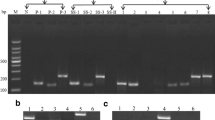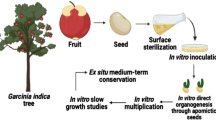Abstract
Infection of field-maintained parthenocarpic Solanum lycopersicum L. (tomato) plants with Tomato yellow leaf curl virus provided the motivation to preserve the germplasm by in vitro methods. In this study, a method for medium-term in vitro conservation of parthenocarpic tomato plants was established. As a preliminary study, the non-parthenocarpic tomato ‘Momotaro’ was used to obtain a number of uniform explants for vegetative propagation under aseptic conditions at 23°C. The modification of sucrose or mannitol concentrations in the medium alone was insufficient for the slow-growth storage of shoot cultures. In contrast, temperature had a considerable effect on the time of conservation. ‘Momotaro’ shoot cultures were pre-cultured with Murashige and Skoog (MS) medium supplemented with 2% (w/v) sucrose at 23°C for 6 d for rooting and were then stored at 10°C for further conservation. When maintained at 10°C, only 27% of the shoot cultures needed subculture even after 3 mo, whereas 100% of plants needed subculturing after approximately 2 wk., when conserved at 23°C. When the same method was used with parthenocarpic tomatoes, plants were successfully conserved at 10°C without subculture for approximately 9 mo. Moreover, field performance and genetic stability of the stored tomato plants were assessed. This newly developed method allows for easy and efficient medium-term in vitro conservation to maintain virus-free parthenocarpic tomato plants.




Similar content being viewed by others
References
Aguilera JG, Pessoni LA, Rodrigues GB, Elsayed AY, DJH DS, De Barros EG (2011) Genetic variability by ISSR markers in tomato (Solanum lycopersicon Mill.). Rev Bras Ciênc Agrár 6:243–252
Ahmed EU, Hayashi T, Yazawa S (2004) Auxins increase the occurrence of leaf-colour variants in Caladium regenerated from leaf explants. Sci Hortic 100:153–159
Al-Abdallat AM, Shibli RA, Akash MW, Rabbaa M, Al-Qudah T (2017) In vitro preservation of transgenic tomato (Solanum lycopersicum L.) plants overexpressing the stress-related SlAREB1 transcription factor. Int J Mol Sci 18:1477
Arizaga MV, Navarro OFV, Martinez CRC, Gutiérrez EJC, Delgado HAL, Yamamoto S, Watanabe K, Niino T (2017) Improvement to the D cryo-plate protocol applied to practical cryopreservation of in vitro grown potato shoot tips. Hort J 86:222–228
Bamberg JB, Martin MW, Abad J, Jenderek MM, Tanner J, Donnelly DJ, Nassar AMK, Veilleux RE, Novy RG (2016) In vitro technology at the US Potato Genebank. In Vitro Cell Dev Biol-Plant 52:213–225
Dodds JH, Huaman Z, Lizarraga R (1991) Potato germplasm conservation. In: Dodds JH (ed) In vitro methods for conservation of plant genetic resources. Chapman and Hall, London, pp 93–109
Engelmann F (1991) In vitro conservation of tropical plant germplasm—a review. Euphytica 57:227–243
Harding K (1991) Molecular stability of the ribosomal RNA genes in Solanum tuberosum plants recovered from slow growth and cryopreservation. Euphytica 55:141–146
Heuvelink E (2005) Tomatoes. CABI Publishing, Oxfordshire
Hosokawa M, Katsumura S, Hayashi T, Yazawa S (2004) Plant regeneration of stable parthenocarpic tomato cultivars from shoot apical meristems attached to root tips. Jpn J Taste Smell Res 11:61–68 (In Japanese)
Huang HP, Wang J, Huang LQ, Gao SL, Huang P, Wang DL (2014) Germplasm preservation in vitro of Polygonum multiflorum Thunb. Pharmacogn Mag 10:179–184
Jain SM (2001) Tissue culture-derived variation in crop improvement. Euphytica 118:153–166
Joyce SM, Cassells AC, Jain SM (2003) Stress and aberrant phenotypes in in vitro culture. Plant Cell Tissue Organ Cult 74:103–121
Kaeppler SM, Kaeppler HF, Rhee Y (2000) Epigenetic aspects of somaclonal variation in plants. Plant Mol Biol 43:179–188
Kataoka K, Nishikawa K, Sakakibara T, Fudano T, Yazawa S (2010) Evaluation of newly developed parthenocarpic strains for production of winter tomatoes without heating. J Japan Soc Agr Tech Man 17:41–45 (In Japanese)
Kataoka K, Okita H, Uemachi A, Yazawa S (2004) A pseudoembryo highly stainable with toluidine blue O may induce fruit growth of parthenocarpic tomato. Acta Hort 637:213–221
Koeda S, Takisawa R, Nabeshima T, Tanaka Y, Kitajima A (2015) Production of Tomato yellow leaf curl virus-free parthenocarpic tomato plants by leaf primordia-free shoot apical meristem culture combined with in vitro grafting. Hort J 84:327–333
Lambardi M, De Carlo A (2003) Application of tissue culture to the germplasm conservation of temperate broad-leaf trees. In: Jain SM, Ishii K (eds) Micropropagation of woody trees and fruits. Kluwer, The Netherlands, pp 815–840
Larkin PJ, Scowcroft WR (1981) Somaclonal variation—a source of variability from cell cultures for plant improvement. Theor Appl Genet 60:197–214
Lizarraga R, Huaman Z, Dodds JH (1989) In vitro conservation of potato germplasm at the International Potato Center. Am Potato J 66:253–269
Lizarraga R, Panta A, Jayasinghe U, Dodds J (1991) Cultivo de tejidos para la eliminacion de patogenos. CIP Research Guide 3, International Potato Center, Lima, Peru
Lopez-Delgado H, Dat JF, Foyer CH, Scott IM (1998) Induction of thermotolerance in potato microplants by acetylsalicylic acid and H2O2. J Exp Bot 49:713–720
Matsuda S, Sato M, Ohno S, Yang SJ, Doi M, Hosokawa M (2014) Cutting leaves and plant growth regulator application enhance somaclonal variation induced by transposition of VGs1 of Saintpaulia. J Japan Soc Hortic Sci 83:308–316
Matsumoto T, Yamamoto S, Fukui K, Rafique T, Engelmann F, Niino T (2015) Cryopreservation of persimmon shoot tips from dormant buds using the D cryo-plate technique. Hort J 84:106–110
Murashige T, Skoog F (1962) A revised medium for rapid growth and bioassay with tobacco tissue culture. Physiol Plant 15:473–497
Neelakandan AK, Wang K (2012) Recent progress in the understanding of tissue culture-induced genome level changes in plants and potential applications. Plant Cell Rep 31:597–620
Ng SYC, Ng NQ (1991) Reduced-growth storage of germplasm. In: Dodds JH (ed) In Vitro methods for conservation of plant genetic resources (pp 11–39). Chapman and Hall, London
Ozudogru EA, Previati A, Lambardi M (2010) In vitro conservation and cryopreservation of ornamental plants. In: Jain SM, Ochatt SJ (eds) Protocols for in vitro propagation of ornamental plants. Humana Press, NewYork, pp 303–324
Pathak MR, Abido MS (2014) The role of biotechnology in the conservation of biodiversity. J Exp Biol Agric Sci 2:352–363
Phillips RL, Kaeppler SM, Olhoft P (1994) Genetic instability of plant tissue cultures: breakdown of normal controls. Proc Natl Acad Sci U S A 91:5222–5226
Reed BM (1992) Cold storage of strawberries in vitro: a comparison of three storage systems. Fruit Varieties J 46:98–102
Ringe F, Nitsch JP (1968) Conditions leading to flower formation on excised Begonia fragments cultured in vitro. Plant Cell Physiol 9:639–652
Roca WM, Chavez R, Martin ML, Arias DI, Mafla G, Reyes R (1989) In vitro methods of germ-plasm conservation. Genome 31:813–817
Rout GR, Mohapatra A, Jain SM (2006) Tissue culture of ornamental pot plant: a critical review on present scenario and future prospects. Biotechnol Adv 24:531–560
Sarkar D, Pandey S, Chanemougasoundharam A (2005) The role of calcium nutrition in potato (Solanum tuberosum) microplants in relation to minimal growth over prolonged storage in vitro. Plant Cell Tissue Organ Cult 81:221–227
Schnapp SR, Preece JE (1986) In vitro growth reduction of tomato and carnation microplants. Plant Cell Tissue Organ Cult 6:3–8
Silva RL, Ferreira CF, Ledo CAS, Souza EH, Silva PH, Costa MAPC, Souza FVD (2016) Viability and genetic stability of pineapple germplasm after 10 years of in vitro conservation. Plant Cell Tissue Organ Cult 127:123–133
Takisawa R, Kataoka K, Kitajima A (2012) Inhibition of seed formation by anomalous ovule in ‘Kyo-temari’, a parthenocarpic tomato (Solanum lycopersicum L.) cultivar. J Japan Soc Hort Sci 81:251–256
Takisawa R, Maruyama T, Nakazaki T, Kataoka K, Saito H, Koeda S, Nunome T, Fukuoka H, Kitajima A (2017) Parthenocarpy in the tomato (Solanum lycopersicum L.) cultivar ‘MPK-1’ is controlled by a novel parthenocarpic gene. Hort J 86:487–492
Tyagi RK, Goswami R, Sanayaima R, Singh R, Tandon R, Agraeal A (2009) Micropropagation and slow growth conservation of cardamom (Elettaria cardamomum Maton). In Vitro Cell Dev Biol-Plant 45:721–729
Veilleux RE, Johnson AAT (1998) Somaclonal variation: molecular analysis, transformation interaction, and utilization. In: Janick J (ed) Plant Breeding Reviews, Volume 16. Avi Publishing Company, Westport, pp 229–268
Westcott RJ (1981) Tissue culture storage of potato germplasm. 2. Use of growth retardants. Potato Res 24:343–352
Withers LA, Engelmann F (1997) In vitro conservation of plant genetic resources. In: Altman A (ed) Biotechnology in agriculture. Marcel Dekker, New York, pp 57–88
Yaacob JS, Mahmad N, Taha RM, Mohamed N, Yussof AIM, Saleh A (2014) Optimization of culture conditions (sucrose, pH, and photoperiod) for in vitro regeneration and early detection of somaclonal variation in ginger lime (Citrus assamensis). Sci World J 2014:1–9. https://doi.org/10.1155/2014/262710
Author information
Authors and Affiliations
Corresponding author
Additional information
Editor: Nancy Reichert
Rights and permissions
About this article
Cite this article
Koeda, S., Matsumoto, S., Matsumoto, Y. et al. Medium-term in vitro conservation of virus-free parthenocarpic tomato plants. In Vitro Cell.Dev.Biol.-Plant 54, 392–398 (2018). https://doi.org/10.1007/s11627-018-9906-1
Received:
Accepted:
Published:
Issue Date:
DOI: https://doi.org/10.1007/s11627-018-9906-1




